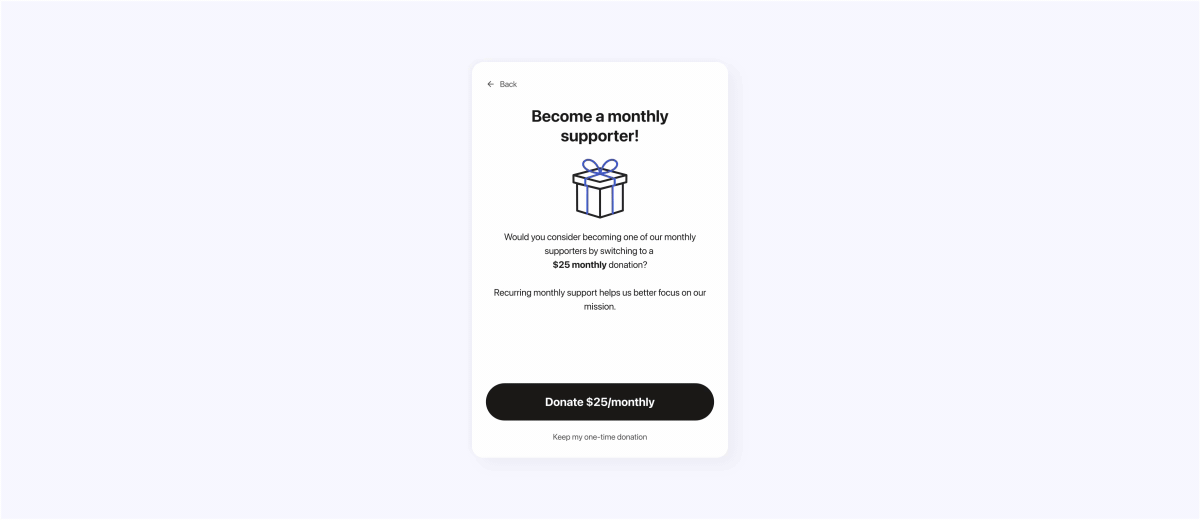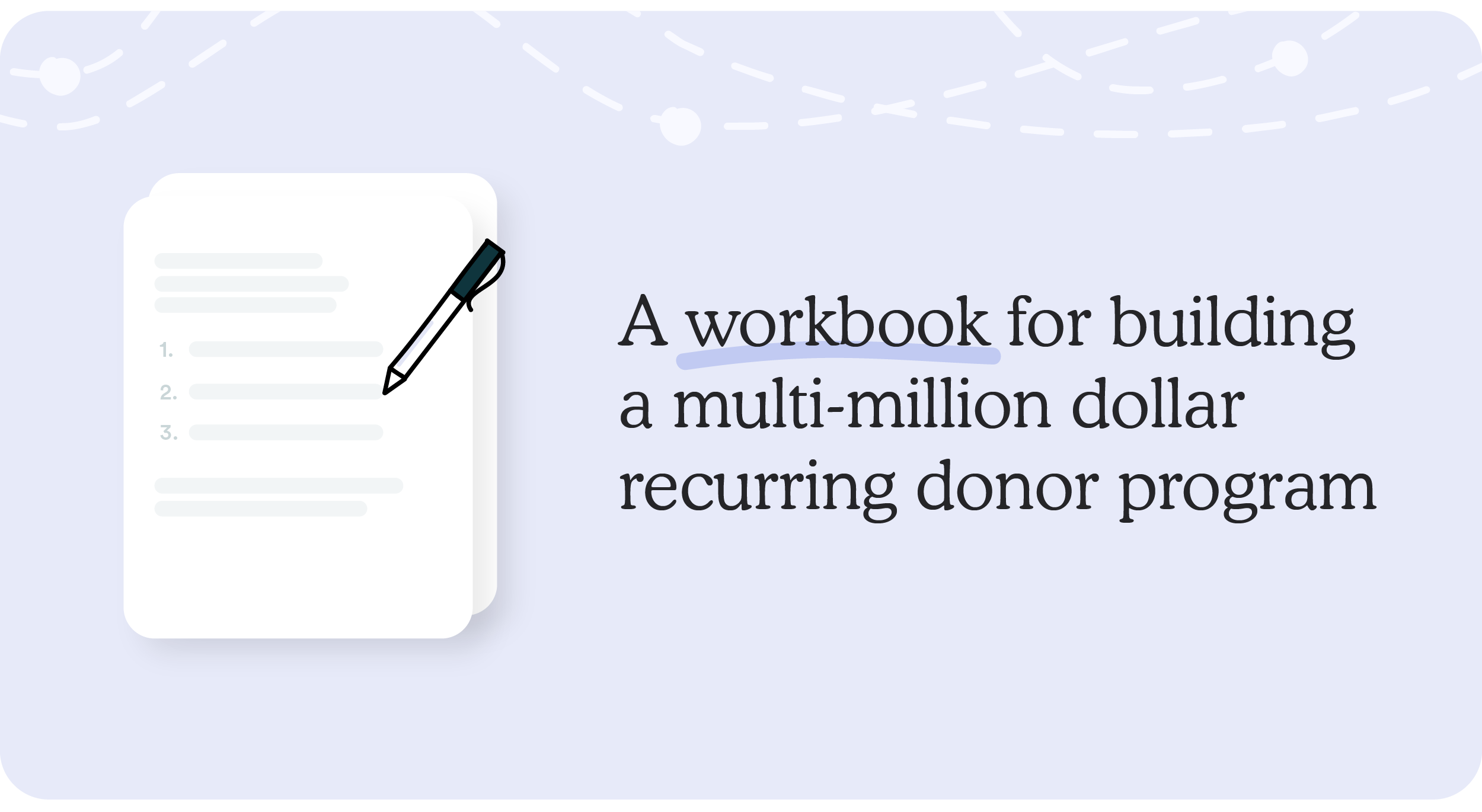Why and How to Invest in Recurring Donations [4 Ways]

Building a strong recurring giving program is no longer a nice-to-have but critical to nonprofits’ sustainability and scalability.
With increased access to innovative online fundraising software, encouraging and accepting recurring donations has become a realistic option for nonprofit organizations of all sizes. Whether you need to create a recurring giving program from scratch or strengthen and grow its existing community, a well-developed program and strategy can protect your organization’s long-term financial health and help you scale it.
Below, we’ll provide more background on the value and appeal of recurring giving in today’s economy and discuss four approaches to building a successful monthly donors program.
What is recurring giving?
Before we discuss the best practices and strategies, let’s clarify what we mean by recurring giving. Recurring donations occur when a donor signs up to give automatically at a specified interval.
Monthly donations are perhaps the most common frequency, but daily, weekly, biweekly, quarterly, semiannual, or annual giving options are available, too.
Many nonprofits also refer to recurring giving as monthly giving or subscription giving.
Why do recurring donation options appeal to donors?
The subscription economy is expected to grow to $1.5 trillion in 2025, double its size five years earlier. From artisan coffees and cat toys to music services and streaming platforms, people have gotten used to the subscription model, paying a set amount each month for goods or services.
In fact, recent surveys have shown that subscriptions are as popular as ever, with 51% of people likely to start a new subscription within the next six months, and 59% saying that excitement is their top emotion when signing up for a new monthly service.
Nonprofits can respond to this consumer shift by rebranding their recurring giving programs as subscription donations and implementing the best practices from today’s most successful subscription services.
With some subtle tweaks and intentional messaging, your nonprofit can capitalize on the ease subscription services offer to take your recurring giving program to the next level.
Here are some pro tips from successful subscription brands that can help you increase recurring donor acquisition and retention rates, allowing you to benefit from consistent online donations from a loyal recurring donor base.
Tip 1: Treat recurring donors as members
Companies like Amazon Prime and Disney+ treat subscribers as members through strategies like special member days and branding. Try giving your recurring donor community a special name and offering members unique opportunities and access throughout the year.
Tip 2: Offer membership tiers
Subscription services often offer price tiers based on users, features, or professional status to balance value and cost. Apply this to donations by promoting giving levels with special perks.
Tip 3: Create a discount option
Another common strategy used with subscription services is offering first-year pricing discounts to encourage new members to join. Nonprofits can institute a “discount” by encouraging donors to request a donation match from their employer to gain the benefits of a higher membership level without paying the additional cost.
Tip 4: Ensure seamless, automated payment
The subscription economy doesn’t rely on members returning each month to settle their bills. Instead, it sets up their payment information once to seamlessly automate the charge at the agreed-upon frequency. Nonprofits can implement modern payment processes for recurring donations through software like Classy Pay, with preferred payment methods, such as credit cards, ACH bank transfer, digital wallets, PayPal, and Venmo.
What are the benefits of a monthly giving program for nonprofits?
Classy’s State of Modern Philanthropy report found that 29% of first-time donors who become recurring donors do so within the first 90 days of their initial gift. Once they’ve established their giving on a recurring basis, these loyal supporters are over 9x more valuable to your nonprofit than one-time donors.
If that’s not enough to motivate you, recurring giving programs also facilitate:
- Increased revenue. Of the top nonprofits on Classy from GoFundMe, nearly 40% of their revenue comes from recurring donors. Even though monthly donors may give smaller amounts on a per-gift basis, the aggregate amount they give annually almost always adds up to more.
- Easy and effective giving processes. A monthly recurring donation allows supporters to spread the financial impact of their giving across the entire year. In our Recurring Donor Sentiment Report, 37% of respondents said they make a recurring gift over a one-time donation because giving in smaller increments is more budget-friendly.
- Improved cash flow. Since nonprofits often receive most of their income during a seasonal donation window, their revenue may feel stretched outside those major giving days. Building a predictable monthly revenue stream helps to reduce this imbalance and provide much-needed support during your organization’s lull periods.
- Better long-term planning. The Fundraising Effectiveness Project’s quarterly fundraising reports have found that repeat donor retention rates have remained steady despite economic fluctuations. As a result, this recurring donation revenue offers greater predictability than one-time donors.
- Greater cost-effectiveness. Once a donor joins your monthly recurring donation program, the gifts continue indefinitely until the donor decides to stop them. You’ll need a retention strategy, of course, but the costs of maintaining donors are generally lower than acquiring new ones.
- Strengthened donor loyalty and engagement. Our Recurring Donor Sentiment Report found that 47% of monthly donors believe their ongoing donation makes a greater impact than a one-time gift. This loyalty to and investment in your mission means they are likely willing to take additional actions for your cause on top of their monthly donations.
- Heightened sense of community. The key to donor retention is nurturing a deep sense of trust, connection, and collaboration with your community. Every month, when a donor makes their contribution, you have the chance to start an organic conversation and remind them of their impact on your nonprofit.
How can nonprofits encourage recurring donations?
A general best practice for inspiring recurring donations is to always have a monthly giving option on your donation forms. This presents an organic opportunity for donors to opt in to ongoing support. When a supporter completes the checkout process on a donation page, this simple prompt can encourage them to upgrade their planned one-time gift to a recurring donation.
Classy Studio makes it easy to add a recurring option on your donation forms, including the ability to apply customizable nudges to draw supporters’ attention to the opportunity. These animated prompts appear when a donor selects a mid-range suggested gift or enters a custom amount that isn’t the highest or lowest option. The nudge draws donors toward the action you want to encourage them to take.

However, remember that people typically won’t give a recurring gift without targeted outreach. That’s why it’s also best practice to have a specific recurring donations campaign that educates your community on the value and impact of the giving type, which we cover more below.
4 types of recurring giving programs to consider
Your nonprofit must decide which type of recurring giving program or strategy best suits your community to incentivize engagement. There are four main approaches to consider. Below, we’ll explain how each works and highlight their benefits and downsides.
1. Create a membership program
Membership programs are an approach to recurring donation programs that invite your donors to join a community of givers. A nonprofit may offer the members of this community certain benefits or perks, such as VIP event tickets, appreciation events, branded membership pins, or other swag. Many nonprofits will also create a specific name for that community and special branding for the program. For example, the Circle of Givers or Champions of Hope.
The key benefit of this approach is that it makes recurring donors feel more valued and connected to a group of like-minded supporters. This is a great marketing strategy as it provides a community feel rather than coming across as transactional.
A potential downside to this giving campaign is that it requires a larger time commitment to keep up with specific member communications, promised incentives, and other program-specific tasks. However, these can all lead to an elevated donor experience that builds loyalty.
2. Offer a sponsorship opportunity
Another approach to recurring giving programs is to frame the donation as a way to sponsor a specific initiative, child, family, animal, or other recipient of your nonprofit’s services.
A key benefit to this recurring fundraising strategy is that it makes the donation experience more personalized and meaningful, as donors feel close and connected to the beneficiary of their gift. Some nonprofits may even be able to facilitate having the child or family write letters to the donor to further build an emotional connection to the cause.
However, one thing to consider with this approach is that typically donations from recurring giving programs are put into a general fund rather than directly sponsoring a specific child or family. This isn’t always the case, but if it is, you may have some challenges with messaging to ensure you’re not misleading your supporters.
3. Encourage giving levels with incentives
Incentive-based programs encourage recurring giving by offering unique incentives for each gift amount, such as branded swag, special communications, or member-only events.
A benefit to this fundraising effort is that incentives can lead to higher monthly gift amounts. In addition, these types of benefits are a nice way to say thank you to donors for choosing to join your cause.
The downside to this approach is that it can be difficult for some nonprofits to afford the incentives. You’ll need to first determine whether it’s worth it to spend money on these items, given the impact you expect it to have on acquiring recurring donors. Then, you may want to see if one of your local partners or a corporate sponsor is willing to help.
4. Highlight items to exchange for a recurring gift
A final approach you can take to your recurring giving strategy is an exchange program. Exchange programs show items people could forgo in exchange for a recurring gift. For example, a new donor could skip a $7 monthly latte to make a donation instead, or an existing donor could gift the money they’d typically spend on a streaming service each month.
The benefit of an exchange program approach is that it’s a good way to motivate donors by showing how easy it is to make an impact.
Test this approach with a specific audience segment first, as it might make more sense for and appeal to younger donors. A time-specific promotional campaign might also be a good opportunity to see if this resonates with your supporters.
Leverage recurring donations to amplify your mission and foster loyal supporters
Nonprofits that apply entrepreneurial thinking when establishing recurring gift programs can meet donors where they are in the current subscription economy and turn one-time gifts into monthly donations. The better the experience you offer recurring donors, the more loyal they become to contributing a reliable income stream.
Regardless of which type of recurring giving program you choose, remember that communication and building relationships with your donors are the most important things.
Focus your energy on making donors feel appreciated, special, and valued. If you need to sacrifice incentives to improve your communication with donors, do it. The goal is to keep your donors happy and build relationships with them that will retain and grow their support over time.
To learn more about building a successful recurring giving program on a donation platform like Classy from GoFundMe, check out our Recurring Giving Playbook. This comprehensive guide will help you discover how to set goals and measure your program’s success, elevate your program with distinct branding elements, craft a compelling email appeal, and more.
Copy editor: Ayanna Julien

Boost your nonprofit’s recurring giving strategy



